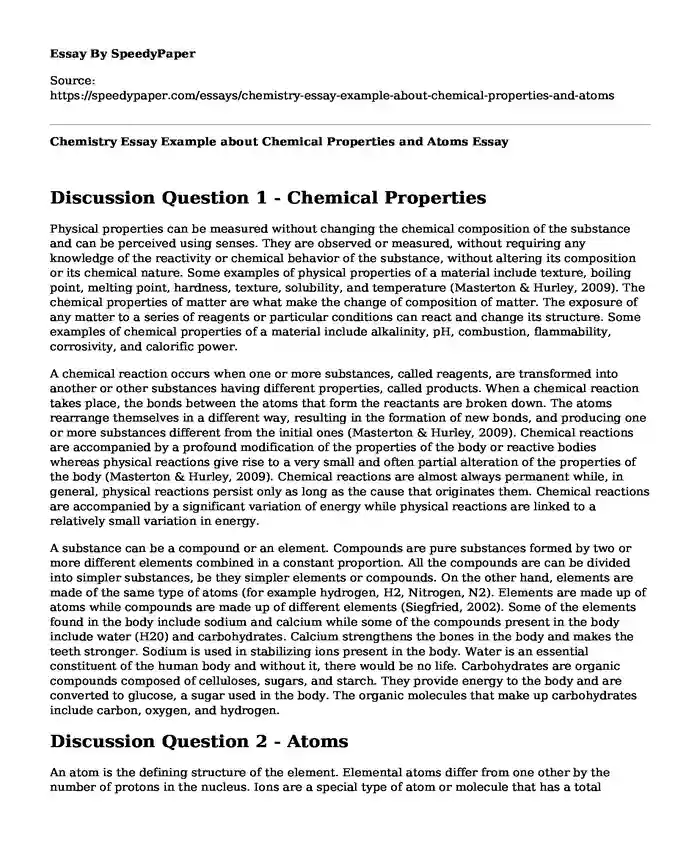Discussion Question 1 - Chemical Properties
Physical properties can be measured without changing the chemical composition of the substance and can be perceived using senses. They are observed or measured, without requiring any knowledge of the reactivity or chemical behavior of the substance, without altering its composition or its chemical nature. Some examples of physical properties of a material include texture, boiling point, melting point, hardness, texture, solubility, and temperature (Masterton & Hurley, 2009). The chemical properties of matter are what make the change of composition of matter. The exposure of any matter to a series of reagents or particular conditions can react and change its structure. Some examples of chemical properties of a material include alkalinity, pH, combustion, flammability, corrosivity, and calorific power.
A chemical reaction occurs when one or more substances, called reagents, are transformed into another or other substances having different properties, called products. When a chemical reaction takes place, the bonds between the atoms that form the reactants are broken down. The atoms rearrange themselves in a different way, resulting in the formation of new bonds, and producing one or more substances different from the initial ones (Masterton & Hurley, 2009). Chemical reactions are accompanied by a profound modification of the properties of the body or reactive bodies whereas physical reactions give rise to a very small and often partial alteration of the properties of the body (Masterton & Hurley, 2009). Chemical reactions are almost always permanent while, in general, physical reactions persist only as long as the cause that originates them. Chemical reactions are accompanied by a significant variation of energy while physical reactions are linked to a relatively small variation in energy.
A substance can be a compound or an element. Compounds are pure substances formed by two or more different elements combined in a constant proportion. All the compounds are can be divided into simpler substances, be they simpler elements or compounds. On the other hand, elements are made of the same type of atoms (for example hydrogen, H2, Nitrogen, N2). Elements are made up of atoms while compounds are made up of different elements (Siegfried, 2002). Some of the elements found in the body include sodium and calcium while some of the compounds present in the body include water (H20) and carbohydrates. Calcium strengthens the bones in the body and makes the teeth stronger. Sodium is used in stabilizing ions present in the body. Water is an essential constituent of the human body and without it, there would be no life. Carbohydrates are organic compounds composed of celluloses, sugars, and starch. They provide energy to the body and are converted to glucose, a sugar used in the body. The organic molecules that make up carbohydrates include carbon, oxygen, and hydrogen.
Discussion Question 2 - Atoms
An atom is the defining structure of the element. Elemental atoms differ from one other by the number of protons in the nucleus. Ions are a special type of atom or molecule that has a total number of electrons (a subatomic particle that give a negative electrical charge) that is not equal to its total number of protons (this makes the atom or molecule to have a positive charge) (Brown, LeMay, Bursten, Murphy, &Woodward, 2009). One common atom is molecular oxygen. The atom oxygen is more stable because its valence shell is shared by electrons from another oxygen atom. The most common ion is O2- which is highly unstable because of its outermost shell has two electrons less. As such, it always tries to bond with other atoms. In the human body, molecular oxygen functions as a part of a water molecule and many other organic molecules. It is also an end product of the metabolism. However, its common ion is produced in mitochondria as by-product of the reactions which disrupts the membrane and damages the cell.
References
Brown, T., LeMay, H., Bursten, B., Murphy, C., & Woodward, P. (2009). Chemistry: The Central Science, AP Edition (11th ed.). Upper Saddle River, NJ: Pearson/Prentice Hall.
Masterton, W., & Hurley, C. (2009). Chemistry: Principles and Reactions (6th edition). Brooks: Cole Cengage Learning.
Siegfried, R. (2002). From elements to atoms: a history of chemical composition. Boston: American Philosophical Society.
Cite this page
Chemistry Essay Example about Chemical Properties and Atoms. (2022, Sep 01). Retrieved from https://speedypaper.net/essays/chemistry-essay-example-about-chemical-properties-and-atoms
Request Removal
If you are the original author of this essay and no longer wish to have it published on the SpeedyPaper website, please click below to request its removal:
- Psychology Essay Example: Salma's Personality
- Career Essay Sample with Reflection on Received 360 Degree Feedback
- Essay Example: Questions and Answers on Philosophy
- Free Essay Sample: Jazz Concert Report
- A Child Called It - Free Essay on the Socialization Lessons in Literature
- Liquidity of Inventory Essay Sample
- Free Business Essay Examples
Popular categories





